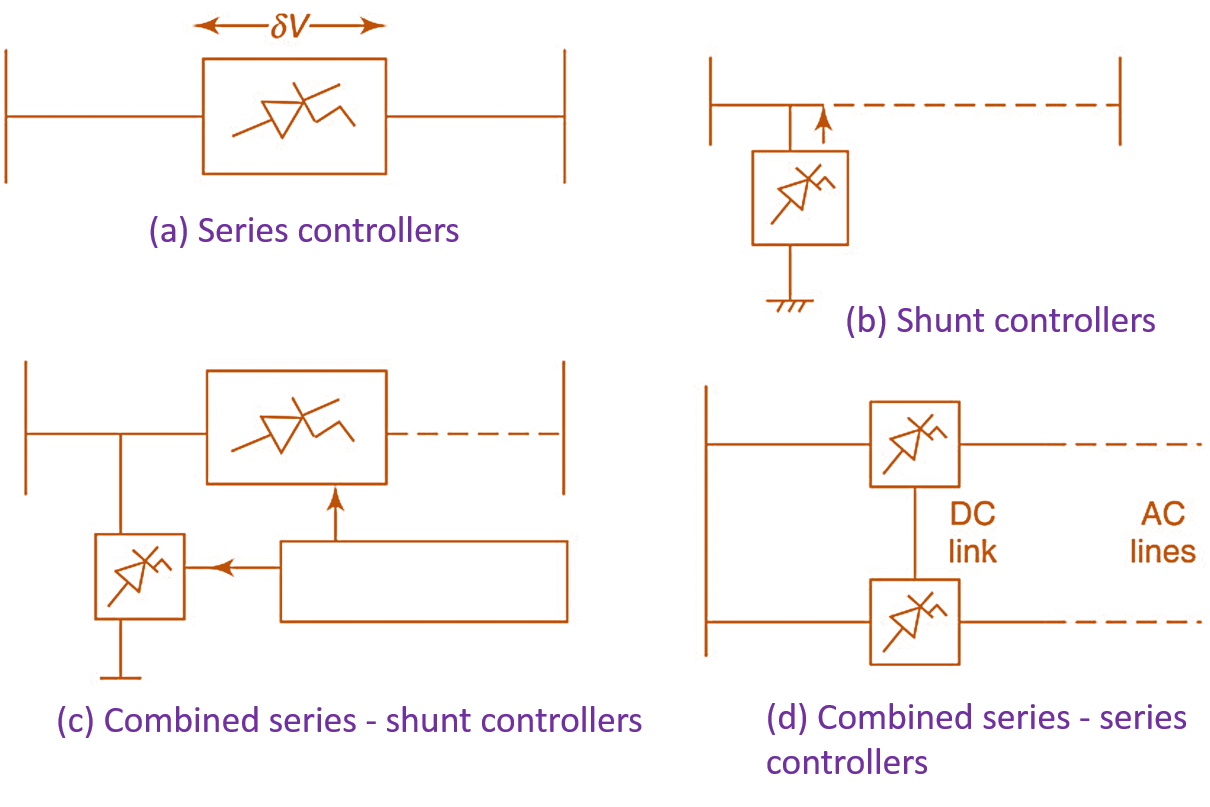In this topic, you study FACTS Devices – Definition, Types, Diagram, Advantages & Applications.
FACTS devices or controllers are power electronic based systems that, with the help other static equipments, provide control of one or more system parameters of a transmission line.
TYPES OF FACTS CONTROLLERS
FACTS controllers can be classified according to the manner in which they are connected in the circuit, as shown in Figure 1. Accordingly, the four basic types of FACTS controllers are
- Series controllers
- Shunt controllers
- Combined series – shunt controllers
- Combined series – series controllers

Figure 1: Types of FACTS controllers
Series Controllers
The series controller may be a variable capacitor, inductor or a variable frequency source. A series controller injects a variable series voltage in the line (Figure 1(a)). A voltage in series with the transmission can control the current flow and thereby the power transfer from the sending to the receiving end. Some of the series controllers are —
- Thyristor-controlled series capacitor (TCSC).
- Thyristor-controlled series reactor (TCSR)
- Static synchronous series compensator (SSSC)
Shunt Controllers
A shunt controller is a variable reactance connected in parallel to transmission line. The controller injects current into the system at the point of connection (Figure 1(b)). Some basic types of shunt controller are
- Static VAR compensator (SVC)
- Static synchronous compensator (STATCOM)
- Static synchronous generator (SSG)
- Thyristor controlled dynamic brake (TCDB)
Series-Shunt Controllers
A combined series-shunt controller has separate series and shunt controllers whose operation is coordinated (Figure 1(c)).
Series-Series Controllers
It is a combination of two or more separate series controllers with each series controller connected in a transmission line or in a multi-line transmission system (Figure 1(d)). All the controllers connected in series are controlled in a coordinated manner.
Advantages of FACTS Devices
The main advantages of using FACTS Devices are
- They help in obtaining optimal system operation by reducing power losses and improving voltage profile.
- Because of the fast controllability of FACTS controllers, the power carrying capacity of lines can be increased upto thermal limits.
- The transient stability limit is increased thereby improving the dynamic security of the system.
- The problem of dynamic over voltages can be overcome by the use of FACTS controller.
Applications of FACTS Devices
The main applications of FACTS Devices are;
- Voltage control using shunt connected controllers.
- Controlled power flow using series connected controllers.
- UPFC can controlled both voltage and power flow.
- Some FACTS controllers such as TCSC can damp the sub-synchronous
Resonance (SSR) experienced in thermal power stations because of the use of fixed series capacitors.